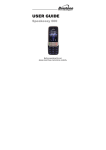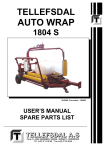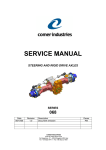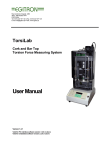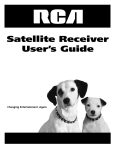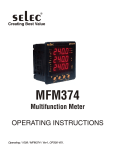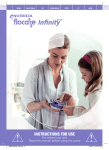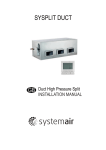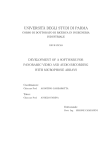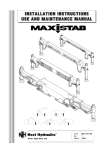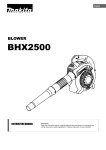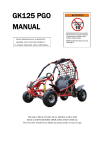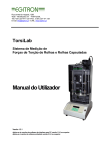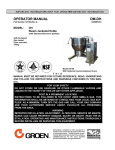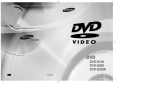Download comer series s128 axle maintenance manual
Transcript
USE AND MAINTENANCE MANUAL – SERIES S128 AXLES CONTENTS 1. PRELIMINARIES .......................................................... 2 1.1. 1.2. 1.3. INTRODUCTION ..........................................................................................................2 ID PLATE .......................................................................................................................2 SAFETY NOTES...........................................................................................................3 2. PROGRAMMED MAINTENANCE ................................ 4 2.1. OIL CHANGE AND PERIODIC AL CONTROLS ......................................................4 3. TROUBLESHOOTING ................................................. 6 3.1. TROUBLESHOOTING.................................................................................................6 4. EXTRAORDINARY JOBS ............................................ 9 4.1. STEERING COMPONENTS.................................................................................... 11 4.1.1. DISASSEMBL Y.................................................................................................. 11 4.1.2. ASSEMBL Y ........................................................................................................ 13 4.2. KNUCKLE AND WHEEL HUB................................................................................. 16 4.2.1. DISASSEMBL Y.................................................................................................. 16 4.2.2. ASSEMBL Y ........................................................................................................ 22 4.3. PLANET GEAR HOLDER HUB............................................................................... 31 4.3.1. DISASSEMBL Y.................................................................................................. 31 4.3.2. ASSEMBL Y ........................................................................................................ 33 4.4. OIL BATH DISK BR AKES ........................................................................................ 35 4.4.1. DISASSEMBL Y.................................................................................................. 35 4.4.2. ASSEMBL Y ........................................................................................................ 40 4.4.3. MECHANIC ALLY DISENGAGING THE NEGATIVE BR AKE .................... 46 4.5. LATER AL BEAM........................................................................................................ 47 4.5.1. DISASSEMBL Y.................................................................................................. 47 4.5.2. ASSEMBL Y ........................................................................................................ 50 4.6. STAND ARD AND LSD DIFFERENTIAL HOUSING ............................................ 55 4.6.1. DISASSEMBL Y.................................................................................................. 55 4.6.2. ASSEMBL Y ........................................................................................................ 57 4.7. CENTRAL BOX AND BEVEL PINION ................................................................... 60 4.7.1. DISASSEMBL Y.................................................................................................. 60 4.7.2. ASSEMBL Y ........................................................................................................ 62 5. TESTING AND FINAL INSTRUCTIONS .................... 66 5.1. 5.2. TESTINGS .................................................................................................................. 66 FINAL INSTRUCTIONS............................................................................................ 66 1 / 66 USE AND MAINTENANCE MANUAL – SERIES S128 AXLES 1. PRELIMINARIES 1.1. INTRODUCTION This manual contains information necessary for carrying out extraordinary maintenance on the differential axle if ever repairs are required of malfunctions connected to it. By always following the instructions given in this manual, the number of hours required for disassembly and assembly will be far less and the risk of incorrect maintenance work minimised. The certainty of a repair job well done is entrusted to people who do this work. It is therefore important that the people assigned to such work receive detailed information about restoring the correct conditions that guarantee operation of the differential axle, limited to the purposes for which it has been designed. This handbook intends explaining to those who actually carry out the e xtraordinary maintenance work on the product, which are the criteria to follow to attain the final result: re-establish and guarantee functionality of the differential axle over time. Hence, this manual must be read by persons authorised to make repairs before they start any such work in order to guarantee the best result. 1.2. ID PLATE Axle identification plate CODE SERIAL NO. Errore. L'orig ine rif erimento non è stata trovata. 2 / 66 USE AND MAINTENANCE MANUAL – SERIES S128 AXLES 1.3. SAFETY NOTES The observance and respect of all existing safety requirements and laws are absolutely essential to protect people from injury and safeguard the product and environment from damage. The repair technicians must have specific skills and expertise to repair these differential axles or similar ones. Without such knowledge, specific training courses must be organised and held by authorised personnel. Repair work must only be done after having read and completely understood all what is written in the instruction Manual as regards to repairs. Before doing any work on the axles, still mounted, the vehicle must be made safe: - Park the vehicle on a flat, solid surface. - Put the work equipment on the ground. - Engage the parking brake. - Turn the engine off. - Take the key out of the ignition. - Lock the wheels of the vehicle with a wedge. - Scrupulously observe the indications given on the warning and indication plates that are on the vehicle. All auxiliary means and tools must be in perfect condition for use and absolutely safe. Errore. L'orig ine rif erimento non è stata trovata. 3 / 66 USE AND MAINTENANCE MANUAL – SERIES S128 AXLES 2. PROGRAMMED MAINTENANCE 2.1. OIL CHANGE AND PERIODICAL CONTROLS Lubricants : SAE 85W90 (API GL4) with additives for oil bath brakes Examples of usable oils: Mobil Super Universal 20W40, Mobil Fluid 422, ELF SF3, AGIP MULTI THT 80W For axles with self-locking differential: SAE 85W90 (API GL5) with additives for oil bath brakes and additives for self-locking differential (LS Limited Slip). Examples of usable oils: SHELL SPIRAX HD 85W90, FUCHS TITAN GEAR 85W90 LS, CASTROL LSC SAE 90, ELF SF3 In both cases we recommend “Shell Donax TD” Brake oil: Use only “Agip ATF II D” mineral oil or alternatively ATF Dexron II oil for the braking system. Grease: We recommend using “Shell Retinax HDX2” grease. The maintenance intervals mentioned are for a normal use of the vehicle; intervals should be shorter if the vehicle is used for particularly hard work. Job Changing axle oil Cleaning the magnetic oil drainage plug Checking and topping up the oil Cleaning the oil breather Greasing (where envisaged) First intervention 200 hours at the first oil change 100 hours 400 hours 200 hours (2) Routine maintenance seasonal/ every 1000 hours (1) at every oil change monthly / every 300 hours (1) monthly / every 300hours (1) weekly / every 200 hours (1)(2) (1) which of the two conditions occurs first (2) 50 hours in the case of hard work Errore. L'orig ine rif erimento non è stata trovata. 4 / 66 USE AND MAINTENANCE MANUAL – SERIES S128 AXLES Axle oil level plug Axle oil drainage plugs Wheel hub draining-filling level plug Axle oil filling and breathing plug Changing the oil: Check the position of the plugs and their function on the axle’s dimensional drawing. Make sure the vehicle is on a flat surface, position the collection trays appropriately and then unscrew the oil drainage plugs. Wait for all the oil to drain from the axle. Filling the rigid axle: The various chambers of the axle are joined together and it is the axle level plug that defines the correct oil level. Pour the oil in through the filling plugs until it starts coming out of the level plug; keep the holes on the hubs open, located above the centre line, to help the air flow. Filling the steering axle: The chambers of the steering units are separate from the axle chambers. Pour the oil in through the filling up plug, located centrally, until the level defined by the level plug is reached. There is just one plug on the steering unit that has the function of draining, level or filling up depending on the position it is in. When it is in the lowest position it acts as the drainage plug, when it is on the centre position it acts as the filling up and level plug. Caution: oil takes time to distribute so you have to wait a few minutes and then add some more oil; continue like this until the level stops going down. Errore. L'orig ine rif erimento non è stata trovata. 5 / 66 USE AND MAINTENANCE MANUAL – SERIES S128 AXLES 3. TROUBLESHOOTING 3.1. TROUBLESHOOTING PROBLEM Bevel gear: CAUSE 1. Gear load is much greater than expected Breakage towards the 2. Incorrect gear external adjustment (too much end of the gear tooth clearance) 3. Pinion ring nut has come loose. Bevel gear: 1. Knocked by the load 2. Incorrect gear Breakage towards the adjustment (too little internal end of the gear clearance) tooth 3. Pinion ring nut has come loose. Bevel gear: 1. Insufficient lubrication 2. Lubricant is dirty Pinion and gear teeth 3. Wrong lubricant or with are worn or scored impoverished additives 4. Pinion bearings are worn, causing incorrect axial clearance of the pinion and contact between pinion and gear Bevel gear: 1. Prolonged operation at Pinion and gear teeth excessive temperatures. overheated. See if the 2. Wrong lubricant colour of the gear teeth has 3. Low oil level altered 4. Lubricant is dirty Bevel gear: 1. Extremely intense use Pitting of pinion teeth 2. Insufficient lubrication Bevel gear: 1. Excessive use Breakage due to fatigue of 2. Continuous overload the pinion tooth (check for characteristic fracture lines) Bevel gear: Impact load of the differential’s components Sudden breakage of the pinion and gear teeth Differential unit: Extremely intense use Differential planet gear Errore. L'orig ine rif erimento non è stata trovata. ACTIONS Replace the bevel gear. Follow the steps carefully that are recommended for adjusting gear tooth and pinion clearance and for detecting tooth impression. Replace the bevel gear. Follow the steps carefully that are recommended for adjusting gear tooth and pinion clearance and for detecting tooth impression. Replace the bevel gear. Replace the pinion’s bearings, making sure the gear, pinion and bearing preloads are arranged correctly. Use the correct lubricant, fill up to the right level and change it at the intervals recommended. Replace the bevel gear. Use the correct lubricant, fill up to the right level and change it at the intervals recommended. Replace the bevel gear. Use the correct lubricant, fill up to the right level and change it at the intervals recommended. Replace the bevel gear. Check and/or replace other differential components. Replace the differential unit. Replace the shaft if 6 / 66 USE AND MAINTENANCE MANUAL – SERIES S128 AXLES grooving worn (too much clearance) Differential unit: 1. Insufficient lubrication Surfaces of the washers of 2. Wrong lubrication the differential gears are 3. Lubricant is dirty worn or marked Pinion unit: Inlet flange’s coupling is worn 1. Extremely intense use grooved 2. Pinion ring nut or flange locking screw has come loose. 3. Pinion axial clearance Beam: The axle’s lateral beam is damaged. Bearings: Wear and pitting of the bearings. Change in colour. Seals and gaskets: Oil leaks from seals and gaskets 1. Vehicle overloaded. 2. Vehicle involved in an accident. 3. Knocked by the load. 1. Insufficient lubrication 2. Lubricant is dirty 3. Extremely intense use 4. Normal wear 5. No longer adjusted correctly. 6. Excessive overheating. 1. Prolonged operation with excessive oil temperature. 2. Oil seal fitted in a wrong way 3. Edge of the seal is cut or corroded 4. Lubricant is dirty Extremely intense use of the vehicle, overloaded Shaft: Shaft deformed or fracturesplit Noise: 1. Too much clearance between the gear and Noise when driving pinion 2. Pinion and gear are worn 3. The pinion bearings are worn 4. Pinion bearings with clearance 5. Differential bearings are worn 6. Differential bearings with clearance 7. Gear not in position 8. Lubricant level low Errore. L'orig ine rif erimento non è stata trovata. necessary. Replace all the washers marked and those that are 0.1 mm thinner than the new ones. Use the correct lubricant, fill up to the right level and change it at the intervals recommended. Replace the flange Check that the grooving of the pinion is not excessively worn Replace the bevel gear if necessary. Replace the axle’s lateral beam and any other damaged components. Replace the bearings. Use the correct lubricant, fill up to the right level and change it at the intervals recommended. Adjust them correctly. Replace the seal and coupling surfaces if damaged. Use the correct lubricant, fill up to the right level and change it at the intervals recommended. Replace the shaft 1. Adjust 2. Replace 3. Replace 4. Adjust 5. Replace 6. Adjust 7. Replace 8. Top up 9. Replace 10. Replace 11. Replace 12. Replace 13. Replace 7 / 66 USE AND MAINTENANCE MANUAL – SERIES S128 AXLES Noise: Noise when idling Noise: Intermittent noise Noise: Noise on a curve 9. Wrong lubricant 10. Shaft is bent 11. Cardan shaft with too much clearance on the spider. 12. Wheel hub bearings worn. 13. Wheel unit gears are excessively worn or damaged. 1. Noise coming from the axle with the vehicle moving are usually heard when idling even if not very loud 2. Incorrect clearance between pinion and gear (the noise heard when decelerating disappears as speed increases). 3. Pinion or inlet flange’s grooved coupling is worn 1. Gear damaged 2. The screws closing the differential unit housing are loose. 1. Differential planet gears worn 2. Differential housing and/or differential pins worn 3. Differential washers worn 4. Grooving on the shaft worn Errore. L'orig ine rif erimento non è stata trovata. 1. Adjust or replace (see above) 2. Adjust 3. Replace 1. Replace the gear 2. Tighten to torque 1. Replace 2. Replace 3. Replace 4. Replace 8 / 66 USE AND MAINTENANCE MANUAL – SERIES S128 AXLES 4. EXTRAORDINARY JOBS DISASSEMBL Y Before carrying out any maintenance work the outside of the transmission must be cleaned with a jet of steam. Seal all openings before doing this so that water and dirt cannot get inside and damage the fundamental parts. To disassemble the axle parts the axle itself has to be taken off the vehicle first. This also entails removing the wheels and the hydraulic pipes from the braking circuit as well as draining the oil from the differential and hubs, removing the plugs. When disassembly is finished, carefully remove the dirt from each single piece, throwing away all those parts that (due to their nature) when assembling, have to be replaced with others in perfect condition: gaskets, seals, worn bearings, screws with worn thread ASSEMBL Y More than 90% of the bearings break due to dirt which is always abrasive. Dirt can get inside the transmission during assembly or be transported by the lubricant during operation. Dirt can also get inside by way of the seals, outlet plugs or even by means of the containers for filling up and changing the oil. Prior to assembly each piece must be cleaned thoroughly and those parts that require it oiled. The components that need oiling must be lubricated with new oil before being assembled. NOTE: When reassembling it is essential to replace all the seals. Take care NOT to pinch the oil retainers during assembly. 9 / 66 USE AND MAINTENANCE MANUAL – SERIES S128 AXLES SPECIAL TOOLS Ref. Code Paragraph Description T01 4.2.2 Wheel hub tapered roller bearing cup driver T02 4.2.2 Wheel hub cassette seal driver T03 4.2.2 Bearing on wheel spindle driver T04 4.2.2 Accessory for wheel hub bearing rolling torquemeter T05 4.2.2 Wheel driver gear on stud bolts driver T06 Knuckle housing bush driver T08 4.2.2 4.5.2 4.2.2 4.5.2 4.2.2 T09 4.3.2 Driver for the needle unit in the planet gear T10 4.4.2 Spring bushing driver. T11 4.4.2 Piston insertion driver T12 4.4.2 Piston insertion driver T13 4.4.2 Brake assembly equipment T14 4.5.2 Ball bearing driver T15 4.5.2 Differential bearing cups driver T16 4.7.2 Pinion bearing cups driver equipment T17 4.7.2 Pinion bearing driver T18 4.7.2 Accessory for torquemeter to check pinion torque T07 Knuckle housing sealing rings driver Accessory for knuckle housing bearing rolling torquemeter Note: The special tools can be purchased directly from Comer Industries or a drawing can be furnished at the Customer’s request. 10 / 66 USE AND MAINTENANCE MANUAL – SERIES S128 AXLES 4.1. STEERING COMPONENTS 4.1.1. DISASSEMBLY 1 Remove the nut (4). 2 Separate the steering tie rod (3) from the knuckle. 3 Unscrew the steering tie rod (3) from the steering cylinder piston rod (1). 11 / 66 USE AND MAINTENANCE MANUAL – SERIES S128 AXLES 4 Remove the securing screws (2) of the steering cylinder (1) to the central housing and retrieve it. 12 / 66 USE AND MAINTENANCE MANUAL – SERIES S128 AXLES 4.1.2. ASSEMBLY 1 Before starting to install the steering cylinder (1) on the central housing check that the cylinder piston rod is centred in relation to the mid-plane, making sure that the piston rod projects equally on both sides. If necessary, centre the piston rod by knocking on the end with a hammer. 2 Place the steering cylinder (1) on the central housing using the securing screws (2). Tighten the screws with a torque wrench to a torque of 15 daNm. 3 Screw the tie rod (3) on to the steering cylinder piston rod (1) with a squarehead wrench (T01) using some Loctite 243. Tighten the tie rod to a torque of 15 daNm. 13 / 66 USE AND MAINTENANCE MANUAL – SERIES S128 AXLES 4 Position the cone of the tie rod (3) in its place on the knuckle. 5 Tighten the nut (4) to a torque of 28 daNm. 6 Check toe-in/toe-out of the steering system by installing a bar on each rim plane. Measure the distance between the two bars at the front (steering cylinder side) and at the back (drive shaft side) of the axle. ATTENTION: the difference between the 2 measurements must not exceed 1 mm. Turn the steering tie rod as illustrated in the figure to achieve bar parallelism: with one wrench hold the cylinder piston rod perfectly still while with the other wrench tighten/loosen the internal thread of the steering tie rod. 7 8 Once parallel, tighten the check nut of the steering tie rod’s internal thread to a torque of 15 daNm and check adjustment of the end of travel screws on the knuckle housing. 14 / 66 USE AND MAINTENANCE MANUAL – SERIES S128 AXLES 9 If a knuckle housing has to be replaced, steer the wheels until one of the housing’s two stops, already adjusted, reaches the end of travel. 1 0 Unscrew the stop on the replaced housing until it comes into contact and then tighten the check nut to a torque of 20 daNm using some Loctite 270. Repeat this, steering in the opposite direction. 1 1 If both knuckle housings are replaced, measure the steering angle and then move the two stops until they come into contact (right wheel and left wheel), tighten the check nut to a torque of 20 daNm with Loctite 270 and repeat but measuring the angle when steering in the opposite direction. 15 / 66 USE AND MAINTENANCE MANUAL – SERIES S128 AXLES 4.2. KNUCKLE AND WHEEL HUB 4.2.1. DISASSEMBLY ATTENTION fasten the steering wheel reduction assembly to a suitable support. 1 Remove the securing screws (7) and extract the bottom knuckle pin (6). 2 Remove the lubricator (5) 16 / 66 USE AND MAINTENANCE MANUAL – SERIES S128 AXLES 3 Remove the securing screws (7) of the top knuckle pin. 4 Extract the top knuckle pin (6) and the shims (8). 5 Retrieve the shims (8). 6 Retrieve the bearing (6*). 7 Separate the steering wheel reduction assembly with double joint from the lateral beam. 17 / 66 USE AND MAINTENANCE MANUAL – SERIES S128 AXLES 8 Remove the two screws (29) securing the planet gear supporting subunit to the hub. 9 Separate the hub planet gear holder subunit (26) from the knuckle unit. ATTENTION: do not let the drive fall – support it with a rope if necessary. 10 Retrieve the O ring (25) from the hub. 11 Remove the seeger ring (24). 12 Remove the washer (23). 18 / 66 USE AND MAINTENANCE MANUAL – SERIES S128 AXLES 13 Pull the double joint (1) out from the knuckle (4). 14 Remove the eight nuts (21) from the stud bolts (9). 15 Remove the closing ring (22). 16 Use two levers to separate the gear holder-gear subunit (14+18+19) from the knuckle housing. NOTE: if the axle is rigid, the subunit is installed directly on the lateral beam. 17 Retrieve the shims (20). 19 / 66 USE AND MAINTENANCE MANUAL – SERIES S128 AXLES 18 Remove the spring ring (14) retaining the gear holder with the aid of a screwdriver. 19 Separate the gear holder (18) from the gear (19). 20 Remove the wheel hub (10+11+12+13) from the housing (4) with an extractor. 21 Separate the hub subunit and retrieve the external bearing (13). 22 Use an extractor to remove the internal bearing (11) from the knuckle housing. subunit knuckle 20 / 66 USE AND MAINTENANCE MANUAL – SERIES S128 AXLES 23 Remove the 2 sealing rings (2) from the knuckle housing (4) with a screwdriver. 24 Remove the bushing (3) from the knuckle housing (4) with a screwdriver. Note: Both the sealing rings (2) and bushing (3) must always be replaced. 25 Remove the internal and external bearing cups (11 and 13) from the wheel hub (12) with a screwdriver. Remove the sealing ring (10) with a screwdriver. Note: The sealing ring must always be replaced. 21 / 66 USE AND MAINTENANCE MANUAL – SERIES S128 AXLES 4.2.2. ASSEMBLY 1 Drive in the cup of the external tapered roller bearing (13) on the wheel hub (12) with the special tool (T01). 2 Drive in the cup of the internal tapered roller bearing (11) on the wheel hub (12) with the special tool (T01). 3 Fit the cassette seal (10) on the wheel hub (12) with the special tool (T02). 22 / 66 USE AND MAINTENANCE MANUAL – SERIES S128 AXLES 4 5 Drive in the internal tapered roller bearing (11) on the spindle of the knuckle housing (4) with the appropriate tool (T03). Attention: if the axle is rigid, the operations are to be done from this stage up to point 4.22 on the rigid housing spindle and not on the knuckle housing. Mount the preassembled hub subunit on the knuckle housing (4) taking care not to damage the sealing ring (10). 6 Drive in the external tapered roller bearing (13) on the spindle of the knuckle housing (4) with the appropriate tool (T03). 7 With the aid of a rubber headed hammer, arrange and adjust the wheel hub bearings to eliminate the preload. 8 Use a torquemeter to check drive torque due to just the oil retaining ring (10). (T04) Accessory for torquemeter. 23 / 66 USE AND MAINTENANCE MANUAL – SERIES S128 AXLES 9 Place the shims (20) on the gear holder (18). 10 Mount the gear holder with shims on the preassembled knuckle housing. 11 Position the closing ring (22). 12 TEMPORARIL Y tighten eight M12 x 1.25x35 screws to a torque of 10 daNm. Attention: do not use any LOCTITE. 13 Once the bearings have been adjusted again on the hub, check the preload value measured as rolling torque with a torquemeter. Accessory (T04). The rolling torque of only the bearings without the oil retaining ring should be between 125 and 155 daNcm. If necessary, remove the gear holder and change the number of shims (20). 24 / 66 USE AND MAINTENANCE MANUAL – SERIES S128 AXLES 14 When the correct preload is reached, remove the eight temporary screws, the closing ring (22), the gear holder (18) and retrieve the shims (20). 15 Mount the gear holder (18) on the gear (19). 16 Fit the spring ring (14) retaining the gear holder. Position the number of shims (20) checked previously on the gear holder (18). 17 Tighten the stud bolts (9) on the knuckle housing (4) using some Loctite 270. Tighten to a torque of 6 daNm. 18 Mount the preassembled gear subunit, gear holder and shims on the knuckle housing with the appropriate driver (T05) 25 / 66 USE AND MAINTENANCE MANUAL – SERIES S128 AXLES 19 Position the closing ring (22). 20 Tighten the nuts (21) on the stud bolts (9) using some Loctite 243. 21 Tighten the nuts (21) to a torque of 10 daNm. 22 Screw the pin-stud bolts (15) on the hub (12) using some Loctite 270. Tighten to a torque of 20 daNm. Note: If the axle is rigid, simply insert the axle shaft, releasing the negative brake if there is one, and then go straight to phase 4.2.2.28 up to 4.2.2.31. 26 / 66 USE AND MAINTENANCE MANUAL – SERIES S128 AXLES 23 Turn the preassembled knuckle housing subunit upside down and put the bushing (3) in place with the specific tool (T06). 24 Fit the 2 sealing rings (2) on the knuckle housing (4) using the special Tool (T07). Apply some Polymer 400 grease. 25 Insert the double cardan joint (1) in the knuckle housing (4) being careful not to damage the sealing rings (2). 26 Fit the washer (23). 27 Fit the Seeger ring (24). 27 / 66 USE AND MAINTENANCE MANUAL – SERIES S128 AXLES 28 Put the O-Ring (25) in its place on the hub (12). 29 Position the preassembled satellite gear holder hub subunit (26) on the hub, matching the holes with those of the securing screws (29) on the wheel hub. 30 Tighten the two securing screws (29) to a torque of 4.5 daNm. 31 Fit the oil filling up/draining plug (28) with washer (27), tightening to a torque of 5 daNm. 32 With the aid of a suitable support, insert the knuckle subunit complete with double cardan joint in the housing, making sure that the grooving on the differential side of the double cardan joint fits into place correctly in the differential gear. WARNING! RELEASE THE NEGATIVE BR AKE, IF THERE IS ONE. 28 / 66 USE AND MAINTENANCE MANUAL – SERIES S128 AXLES 33 Fit the ball bearing (6*) on the knuckle pin (6). 34 Position the shims (8) on the top ball knuckle pin (6). 35 Mount the top ball knuckle pin (6) on the housing, partially tightening the screws (7) 36 Mount the bottom ball knuckle pin (6). 37 Tighten the screws (7) to a torque of 15 daNm. 29 / 66 USE AND MAINTENANCE MANUAL – SERIES S128 AXLES 38 Tighten the screws (7) of the top ball knuckle pin to a torque of 15 daNm. 39 Check the preload value of the ball knuckle bearings measured as rolling torque with a torquemeter. Rolling torque should be between 5 and 8 daNm. (T08) Accessory for torquemeter If necessary, remove and change the number of shims (8). 40 Mount the lubricators on the top and bottom ball knuckle pins (5). Tighten them to a torque of 1.5 daNm. 30 / 66 USE AND MAINTENANCE MANUAL – SERIES S128 AXLES 4.3. PLANET GEAR HOLDER HUB 4.3.1. DISASSEMBLY 1 Remove the two screws securing the planet gear holder support subunit to the hub. 2 Separate the planet gear holder support subunit and lay it on a flat surface. 3 Take the Seeger ring (4) off with a pair of pliers. 31 / 66 USE AND MAINTENANCE MANUAL – SERIES S128 AXLES 4 Remove the three planet gears (5) with an extractor and separate the needle bearing (3). 5 Check the state of wear of the parts, replacing them if necessary. If the axle shaft stopper is damaged replace the whole planet gear holder (1 and 2). 32 / 66 USE AND MAINTENANCE MANUAL – SERIES S128 AXLES 4.3.2. ASSEMBLY 1 Punch mark the axle shaft stopper (2) in 3 points on the planet gear holder (1). 2 Mount the needle bearing (3) on the planet gear (5) with the special tool (T09). 3 Check correct mounting of the needle bearing (3) on the planet gear (5) with a depth gauge. The depth measured in the figure must be equal to 6 (+/- 0.5) mm. 33 / 66 USE AND MAINTENANCE MANUAL – SERIES S128 AXLES 4 Position the planet gear (5) with preassembled needle bearing on the pin of the planet gearholder (1) taking care to position it in the direction shown in the figure. The rounded end of the needle bearing (3) is to go at the bottom. 5 Drive in the planet gear with needle bearing (5 + 3) on the planet gear holder pin (1) with the special tool (T09). 6 Fit the retaining Seeger ring (4) on the pin. To make doubly sure that mounting is correct, check that the surface of the planet gear and the machined surface of the pin are the same height. 34 / 66 USE AND MAINTENANCE MANUAL – SERIES S128 AXLES 4.4. OIL BAT H DISK BRAKES 4.4.1. DISASSEMBLY 1 2 Once the housing has been removed from the centre of the axle, see paragraph 4.5.1 Removing the brake components from the housing: Remove the spring ring (7) paying attention to the counter steel disk which is pushed towards the outside by the 2 springs (3). Remove the first counter disk (6). Attention: if the brake disk package does not have to be replaced we suggest numbering the position of the counter disks and disks to ensure they are put back in the same position. 3 Retrieve the 2 springs (3). 35 / 66 USE AND MAINTENANCE MANUAL – SERIES S128 AXLES 4 Remove the first brake disk (5), the following counter disk (6) and the second brake disk (5) in this order. 5 Remove the bushing (4). 6 Remove the steel counter disk (6). 7 Remove the last brake disk (5). 8 Disassembling the brake unit: Remove the screws (25) securing the brake housing (16) to the central box (24). 36 / 66 USE AND MAINTENANCE MANUAL – SERIES S128 AXLES 9 Remove the brake housing (16) with all the preassembled components inside it from the central box (24). 10 Remove the spring holder ring (22) with all the springs (20 and 21). There are two springs for each hole and can be extracted one at a time. 11 Retrieve the O ring (23) from its place in the central box. 12 The negative brake piston (19) can be extracted with compressed air. 13 Take the O ring (17) off. 37 / 66 USE AND MAINTENANCE MANUAL – SERIES S128 AXLES 14 Take the O ring (18) off. 15 Unscrew the nuts (8). 16 Retrieve the washers (9) and spacers (11) 17 Push the piston (13) from the side opposite the brake housing (16) to remove it. 18 Take the two O rings (14 and 15) out. 38 / 66 USE AND MAINTENANCE MANUAL – SERIES S128 AXLES 19 Unscrew the stud bolts (12). 20 Use a punch driver to take the spring bushes (10) out of the piston (13). 39 / 66 USE AND MAINTENANCE MANUAL – SERIES S128 AXLES 4.4.2. ASSEMBLY 1 Assembling the brake unit: Drive (with tool T10) the spring bushes (10) in the piston (13), inserting them from the rounded part and pushing them right down to the opposite surface of the flange. The surface of the rounded part of the bush must be the same height as the piston surface. 2 Mount the stud bolts (12) with some Loctite 270, tightening them to a torque of 1.5 daNm 40 / 66 USE AND MAINTENANCE MANUAL – SERIES S128 AXLES 3 Put the oiled O ring (14) in its place. 4 Put the oiled O ring (15) in its place. 5 Position the piston (13) in the correct phase, determined by the stud bolts and by the two projecting parts of the piston. 6 Put the piston (13) in its place, taking care not to damage the O rings. (T11) Driver 7 Put the spacers (11) in place. 41 / 66 USE AND MAINTENANCE MANUAL – SERIES S128 AXLES 8 Fit the washers (9). 9 Put the self-locking nuts (8) in and tighten them to a torque of 1.2 daNm 10 Put the adequately oiled O ring (18) in place. 11 Put the adequately oiled O ring (17) in place. 12 With the appropriate driver (T12) put the piston (19) in its place, taking care not to damage the O rings. 42 / 66 USE AND MAINTENANCE MANUAL – SERIES S128 AXLES 13 Put the spring holder ring (22) in its place obtained in the central box (24). 14 Put the O ring (23) in its place obtained in the central box. 15 Put the springs (20 and 21) in each hole of the flange (22). 16 Drive the pins (26) into the central box. 17 Position the brake unit on the central box and tighten the screws (25) to a torque of 4.5 daNm. In the presence of a negative brake and before proceeding with the next operations, power the negative brake circuit with a pressure of at least 15 bar (no more than 30 bar) and then, with a rubber headed hammer, move the positive brake piston (13) back into its initial position against the inner surface 43 / 66 USE AND MAINTENANCE MANUAL – SERIES S128 AXLES seeing as when the securing screws of the brake unit were tightened, it was pushed towards the outside by the springs (20 and 21). Alternatively, axle assembly can be completed but in this case, before installation on the vehicle, it will be necessary to proceed as explained in paragraph 4.4.3, but this time tightening the screws right down. 18 Put the O ring in its place obtained in the brake unit housing. Insert a brake disk (5) in the lateral beam (1). 19 Then insert the steel counter disk (6). 20 Insert the bush (4) as shown in the figure. 44 / 66 USE AND MAINTENANCE MANUAL – SERIES S128 AXLES 21 Insert the second brake disk (5) followed by the second steel counter disk (6) and lastly the third brake disk (5). Pay attention to the brake disks – they must be put so the passage holes match. 22 Insert the 2 springs (3) in the two blind holes in the housing (1). 23 Position the last counter disk (6). 24 Either using the tool (T13) or keeping the counter disk pressed, put the spring ring (7) in its place in the housing (1). 25 Check correct opening of the spring ring. The open part of the ring must coincide with the threaded oil drainage hole. Mount the housing on the central part, see paragraph (4.5.2) 45 / 66 USE AND MAINTENANCE MANUAL – SERIES S128 AXLES 4.4.3. MECHANICALLY DISENGAGING THE NEGATIVE BRAKE If there is a failure with the vehicle and it needs to be towed, the negative brake (where foreseen) will need to be mechanically disengaged. Attention!!! When mechanically disengaging the negative brake, the service brake will be unusable therefore the vehicle must be kept still and safe using suitable methods (ropes, wedges, etc.) Completely undo the 2 screws (1) on the beam (3), remove the spacer 2 and then retighten the screws (1) on the beam (3). Attention: the screws must be tightened alternately, turning them 45° at a time; do not tighten completely one screw and then the next. It is unnecessary to tighten the screws completely – stop as soon as the brake is disengaged. Proceed in the reverse order to reengage the negative brake. 46 / 66 USE AND MAINTENANCE MANUAL – SERIES S128 AXLES 4.5. LATERAL BEAM 4.5.1. DISASSEMBLY 1 Put the axle on supports able to withstand the weight of the central body and the two lateral beams even after they have been separated or anchor the three units individually with ropes or belts to a lifting system. Undo the screws (11) of the beam and retrieve the washers. 2 Separate the lateral beam (5) from the central unit. ATTENTION do not let the flange (8) fall that is supporting the differential unit. If the a xle has brakes see (4.4.1) 3 Remove the o-ring (7) 47 / 66 USE AND MAINTENANCE MANUAL – SERIES S128 AXLES 4 Remove the flange (8) 5 Remove the bearing cap (15) Attention: if the axle has brakes then this and the next 2 operations are to be done inside the brake unit. 6 Retrieve the shims (13). 7 Take the Seeger ring (12) out of its place. 8 Retrieve the felt rings (3). 48 / 66 USE AND MAINTENANCE MANUAL – SERIES S128 AXLES 9 Use the extractor to remove the spherical cap (4) from the housing. 10 Remove the two oil retaining rings (1) with a screwdriver. 11 Remove the screwdriver. bush (2) with a 49 / 66 USE AND MAINTENANCE MANUAL – SERIES S128 AXLES 4.5.2. ASSEMBLY 1 2 If the a xle is rigid go to phase 4. Drive the bushing (2) with the special tool (T06) into the housings (5). Drive 2 sealing rings (1) into the housing (5 ) with the special tool (T07). Grease the oil retainers with Polymer 400 50 / 66 USE AND MAINTENANCE MANUAL – SERIES S128 AXLES 3 Drive in the spherical cap (4) with the tool (T14) 4 Put the Seeger ring (12) in its place. 5 Insert the shims (13). Roughly the same number of shims that were there when disassembling must be put back. It will later be checked to see if the number is correct. 6 Drive in the bearing cap (15) with the tool (T15) 51 / 66 USE AND MAINTENANCE MANUAL – SERIES S128 AXLES 7 Brush some of the gear and pinion teeth with a marking product (i.e. ink) to later verify perfect contact of the bevel gear teeth. 8 Put the flange (8) in its place. Note: If it is the flange on the differential gear side you will first need to put the differential unit inside the central box. 9 Put the O rings (7) and pins (14) in place in the central box. 10 Arrange the housing (5) on the central box, turning the flange (8) underneath if necessary, depending on the position of the hollow in the housing. 11 Tighten the screws (11) with their washers to a torque of 15 daNm 52 / 66 USE AND MAINTENANCE MANUAL – SERIES S128 AXLES ADJUSTING ADJUSTING 12 The number of shims (13) for adjusting the tapered roller bearings (15) must be such to have a clearance of 0.15 to 0.30 mm between the teeth of the bevel gear and bearing (14) pre-load measured as an INCREASE of the rolling torque in input to the pinion must be as given in the following table. ratio C/C rolling torque INCREASE measured on the pinion with a torquemeter (daNcm) 9:37 12:39 14:38 17:38 3-5 4-7 4-8 5 - 10 Measure the clearance between gear and bevel pinion. Measure the torquemeter. ADJUSTING 13 rolling torque with a Mo ve some of the shims (13) from the bearing on the right to the bearing on the left to either increase or reduce torque clearance, increase or reduce the number of shims to increase or reduce the rolling torque. This does mean of course that the lateral beams will have to be disassembled and re-assembled if the axle has no brakes. If the axle does have brakes, simply remove the Seeger (12) leaving the brake units in place. Check the goodness of the contacts between the bevel gear teeth, disassembling and reassembling the lateral beam (on the gear side) completely and extracting the differential housing assembly. An incorrect contact can give problems of noise and duration of the bevel gear. 53 / 66 USE AND MAINTENANCE MANUAL – SERIES S128 AXLES Use the pinion shims to correct contact position, bringing clearance back to the established values. 54 / 66 USE AND MAINTENANCE MANUAL – SERIES S128 AXLES 4.6. STANDARD AND LSD DIFFERENT IAL HOUSING 4.6.1. DISASSEMBLY 1 Remove the two tapered roller bearings (1) from the half housings (10) and (11) using an extractor. Retrieve the shims (2) from both sides of the differential housing. 2 Undo the securing screws (8) of the bevel crown (9) from the differential housing and separate the crown gear. 3 Separate the differential half housings (10) and (11). 55 / 66 USE AND MAINTENANCE MANUAL – SERIES S128 AXLES 4 Remove the planet gears (6) and relative spherical washers (5) separating them from the spider (7). 5° Retrieve the friction disk pack (3) of the Limited Slip device from the planet gear (4). Check wear status and, if necessary, replace the disk pack. NOTE: keep the disk pack in the right sequence to ensure correct assembly – see figure. 5b In versions with the STANDARD differential, there is a washer on the planet gear (4) instead of the friction disk pack. 56 / 66 USE AND MAINTENANCE MANUAL – SERIES S128 AXLES 4.6.2. ASSEMBLY 1 Pre-assemble the planet gears (6) with their spherical washers (5) on the spider (7). 2° Mount the friction disk pack (3) on the planet gears (4). NOTE: Observe the sequence of the disks illustrated in the figure. 2b In versions with the STANDARD differential the washer must be used instead of the friction disk pack. 57 / 66 USE AND MAINTENANCE MANUAL – SERIES S128 AXLES 3 Install the planet gears (4) in the half housings (10) and (11). 4 Position the pre-assembled spider in the differential half housing (10), identified by its threaded holes. 5 Couple the half housing (11) to the half housing (10), observing the matching as indicated in the figure. Refer to the matching of the two numbers printed on the 2 half housings. 6 Mount the bevel crown (9) on the preassembled differential unit, tightening the screws (8). Apply some Loctite 270 on the threads. 58 / 66 USE AND MAINTENANCE MANUAL – SERIES S128 AXLES 7 Tighten the screws (8) at a torque of 25 daNm. 59 / 66 USE AND MAINTENANCE MANUAL – SERIES S128 AXLES 4.7. CENTRAL BOX AND BEVEL PINION 4.7.1. DISASSEMBLY 1 Remove the caulked ring nut (8) 2 Remove the anti-rotation washer (7) 3 Remove the tapered roller bearing (6), knocking on the ends of the pinion with a rubber headed hammer. 60 / 66 USE AND MAINTENANCE MANUAL – SERIES S128 AXLES 4 Retrieve the bevel pinion (2) and remove the collapsible spacer (5). ATTENTION: the collapsible spacer must necessarily be replaced. 5 Remove the under-head tapered roller bearing (3) from the pinion. 6 Remove the cup of the pinion underhead tapered roller bearing (3). 7 Retrieve the bevel gear set adjustment shims (4). 8 Remove the cup of the external tapered roller bearing (6). 61 / 66 USE AND MAINTENANCE MANUAL – SERIES S128 AXLES 4.7.2. ASSEMBLY 1 Read measurement “X” printed on the head of the bevel pinion (2). To find the right number of shims to set adjust the bevel gear, find measurement A (from the centre of the housing to its edge) and the height between the two surfaces of the bearing (3). All you need then do is subtract the height of the bearing and the measurement printed on the pinion from measurement A and the result is the height you have to have with the shims. 2 Put the correct number of shims (4) under the internal bearing cap (3). Attention: this is fundamental to ensure correct operation of the bevel gear. 62 / 66 USE AND MAINTENANCE MANUAL – SERIES S128 AXLES 3 Put the internal bearing cap (3) in place. 4 Put the external bearing cap (6) in place. 5 Put the two caps in place with the relative tool (T16). The caps can be driven in with a hammer and driver but be sure they are both positioned correctly. 6 Drive the bearing (3) on the pinion with the tool (T17) 7 Insert the collapsible spacer (5) which has to be replaced each time any work is done on the pinion unit. 63 / 66 USE AND MAINTENANCE MANUAL – SERIES S128 AXLES 8 Put the pinion (2) in the central box (1). 9 After having seen to preparing an adequate support for the pinion, drive in the other bearing (6) with the driver (T17). 10 Insert the washer (7) in the correct phase with respect to the seat on the pinion. 11 Tighten the ring nut (8) with some Loctite 270 and keep the pinion blocked and perfectly still until a rolling torque of 4 to 7 daNcm is reached 12 Measuring the rolling torque with a torquemeter. (T18) Accessory for torquemeter. 64 / 66 USE AND MAINTENANCE MANUAL – SERIES S128 AXLES 13 With a punch driver, caulk the ring nut (8) in place on the pinion, taking care not to break the edge of the ring nut. 65 / 66 USE AND MAINTENANCE MANUAL – SERIES S128 AXLES 5. TESTING AND FINAL INSTRUCTIONS 5.1. TESTINGS Block the input pinion. If the axle is installed on the vehicle, put it in gear. With the help of another person standing on the other side, test correct assembly by turning both wheels as much as possible moving forwards. (Both wheels should block shortly after). With the pinion still blocked, release the right wheel and turn the left wheel moving forwards. If assembly is correct, the left wheel should be turning freely without any effort and the right wheel should be turning (also freely) in the opposite direction (reverse). Repeat in the opposite direction. IF ONE OF THE WHEELS IS NOT TURNING FREELY check complete assembly of the axle again. 5.2. FINAL INSTRUCT IONS Check correct filling up of the lubricating oil in the transmission. See paragraph 2.1. Bleed the air from the circuit that feeds the oil bath disk brakes. 66 / 66


































































